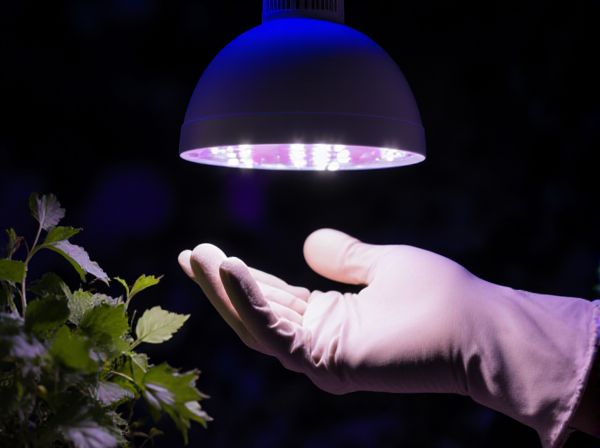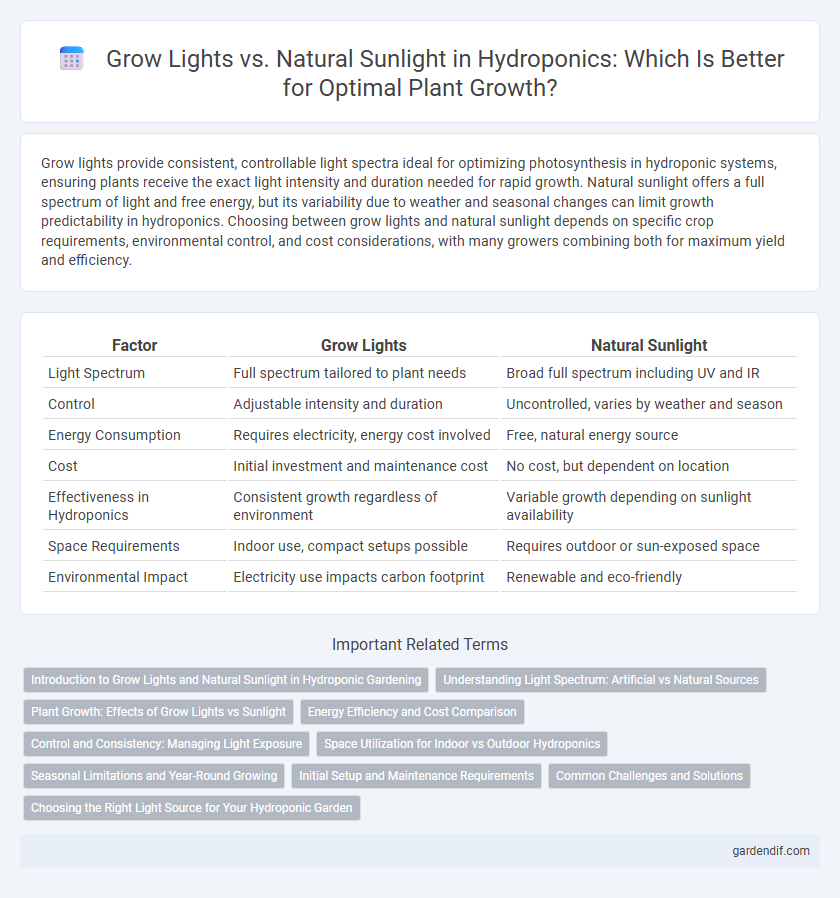
Grow Lights vs Natural Sunlight Illustration
Grow lights provide consistent, controllable light spectra ideal for optimizing photosynthesis in hydroponic systems, ensuring plants receive the exact light intensity and duration needed for rapid growth. Natural sunlight offers a full spectrum of light and free energy, but its variability due to weather and seasonal changes can limit growth predictability in hydroponics. Choosing between grow lights and natural sunlight depends on specific crop requirements, environmental control, and cost considerations, with many growers combining both for maximum yield and efficiency.
Table of Comparison
| Factor | Grow Lights | Natural Sunlight |
|---|---|---|
| Light Spectrum | Full spectrum tailored to plant needs | Broad full spectrum including UV and IR |
| Control | Adjustable intensity and duration | Uncontrolled, varies by weather and season |
| Energy Consumption | Requires electricity, energy cost involved | Free, natural energy source |
| Cost | Initial investment and maintenance cost | No cost, but dependent on location |
| Effectiveness in Hydroponics | Consistent growth regardless of environment | Variable growth depending on sunlight availability |
| Space Requirements | Indoor use, compact setups possible | Requires outdoor or sun-exposed space |
| Environmental Impact | Electricity use impacts carbon footprint | Renewable and eco-friendly |
Introduction to Grow Lights and Natural Sunlight in Hydroponic Gardening
Grow lights provide a controlled and consistent light spectrum essential for photosynthesis in hydroponic gardening, ensuring optimal plant growth regardless of external weather conditions. Natural sunlight offers a full spectrum of light, promoting healthy development and energy efficiency, but its availability varies with season and location. Hydroponic systems leveraging both grow lights and sunlight optimize plant yield by balancing intensity, duration, and spectral quality for different growth stages.
Understanding Light Spectrum: Artificial vs Natural Sources
Understanding the light spectrum is crucial for optimizing hydroponic growth, as artificial grow lights can be tailored to emit specific wavelengths that enhance photosynthesis and plant development. Natural sunlight provides a full spectrum of light, including UV and infrared, which supports diverse physiological processes but varies in intensity and duration throughout the day. Advanced LED grow lights offer precise control over light spectra, allowing growers to maximize growth efficiency and crop yield in controlled environments.
Plant Growth: Effects of Grow Lights vs Sunlight
Grow lights provide a controlled light spectrum and intensity that can be tailored to optimize photosynthesis and plant growth, often resulting in faster development and higher yields compared to natural sunlight. Natural sunlight offers a full spectrum of wavelengths essential for robust plant health but varies in intensity and duration based on geographic location and weather conditions. Studies show that combining grow lights with natural sunlight can enhance plant growth by ensuring consistent light exposure and filling gaps during low sunlight periods.
Energy Efficiency and Cost Comparison
Grow lights, particularly LED models, offer superior energy efficiency by consuming up to 80% less electricity compared to traditional lighting and providing consistent light spectrum tailored for hydroponic plant growth. While natural sunlight is free, it is inconsistent and limited by weather and daylight hours, potentially reducing crop yields and extending growth cycles. The initial investment in grow lights is offset by long-term savings on electricity costs and increased productivity, making them a cost-effective solution for controlled environment agriculture.
Control and Consistency: Managing Light Exposure
Grow lights offer precise control over light spectrum, intensity, and duration, enabling consistent and optimized growth conditions for hydroponic plants regardless of external weather or seasonal changes. Unlike natural sunlight, which varies daily and seasonally, grow lights ensure plants receive uniform light exposure, reducing stress and promoting steady development. This consistency enhances photosynthesis efficiency and crop yields in controlled environment agriculture.
Space Utilization for Indoor vs Outdoor Hydroponics
Grow lights enable precise control over light intensity and duration, optimizing space utilization in indoor hydroponic systems by allowing vertical stacking and year-round cultivation irrespective of outdoor conditions. Natural sunlight in outdoor hydroponics offers full-spectrum light but limits spatial arrangement due to dependency on weather patterns and daylight hours, often requiring larger surface areas. Efficient space use in indoor setups with grow lights supports higher crop density and consistent yields, whereas outdoor systems benefit from natural conditions but face spatial and temporal constraints.
Seasonal Limitations and Year-Round Growing
Grow lights provide consistent light intensity and spectrum unaffected by seasonal changes, enabling year-round hydroponic cultivation regardless of natural sunlight availability. Natural sunlight varies in duration and intensity with seasons, limiting plant growth during shorter, darker days and affecting crop yield consistency. Implementing grow lights overcomes these seasonal limitations, ensuring optimal photosynthesis and continuous plant development throughout the year.
Initial Setup and Maintenance Requirements
Grow lights require an initial investment in quality LED or fluorescent fixtures and often involve electrical setup, whereas natural sunlight has zero setup cost but depends on the location and season. Maintenance for grow lights includes periodic bulb replacement and electricity expenses, contrasting with sunlight which demands minimal upkeep but may necessitate strategic placement and supplemental lighting during low light periods. Both options influence crop yield consistency, with grow lights offering controlled light schedules and intensity, while sunlight provides a broad spectrum ideal for plant growth but with variable availability.
Common Challenges and Solutions
Grow lights often face challenges such as insufficient spectrum variety and inconsistent intensity, which can be addressed by using full-spectrum LED lights tailored for plant growth cycles. Natural sunlight may present issues like variable weather conditions and inadequate exposure during shorter days, solvable through supplemental lighting and strategic placement of hydroponic systems. Both methods require careful monitoring of light duration, intensity, and quality to optimize photosynthesis and promote healthy plant development.
Choosing the Right Light Source for Your Hydroponic Garden
Selecting the ideal light source for your hydroponic garden depends on balancing energy efficiency, spectrum quality, and plant growth stages. LED grow lights offer customizable light spectrums and consistent intensity, making them suitable for optimizing photosynthesis indoors. Natural sunlight provides full-spectrum light at no cost but can be inconsistent due to weather and seasonal variations, affecting crop yield reliability.
Grow Lights vs Natural Sunlight Infographic

 gardendif.com
gardendif.com